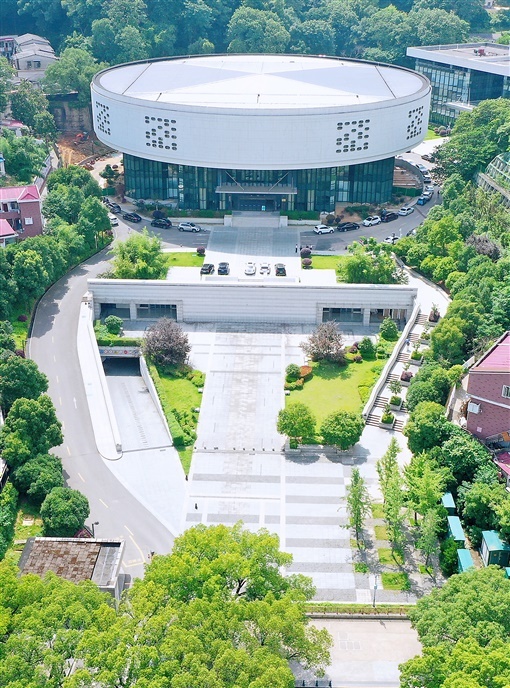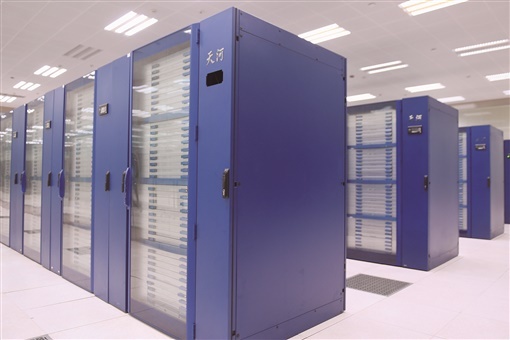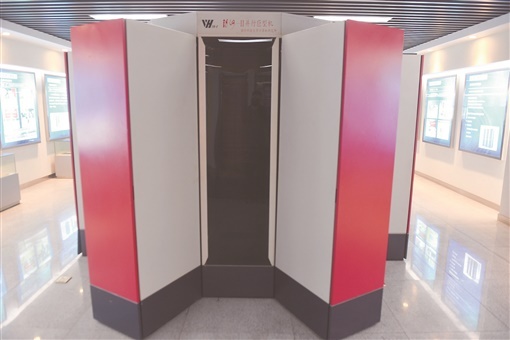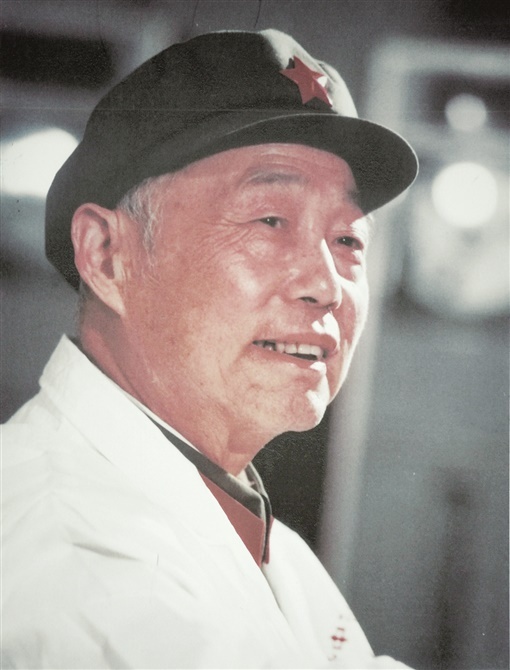[Business Card]
"Tianhe" series of supercomputers, a supercomputer system developed by the School of Computer Science of National Defense University of Science and Technology, including models such as "Tianhe-1" and "Tianhe-2". In November 2010, "Tianhe-1" left the name of China’s supercomputer for the first time in the top 500 supercomputers in the world; from June 2013 to November 2015, "Tianhe-2" ranked first in the world’s top 500 supercomputers for six consecutive times.

(The National Supercomputing Changsha Center is located under Yuelu Mountain. Photo by Hunan Daily All Media Reporter Xu Xing)
After the successful development of "Tianhe-2", the General Secretary of the Supreme Leader made an important instruction: "The successful development of the Tianhe-2 supercomputer system marks that our country has taken the lead in the world in the field of supercomputers. I hope that comrades will sum up their experience, make persistent efforts, insist on giving priority to me, have the courage to innovate independently, and constantly strengthen cutting-edge technology research, so as to make greater contributions to promoting our country’s scientific and technological progress and building an innovative country."
Today, the "Tianhe" series deployed in the National Supercomputing Center Tianjin, Guangzhou Center, Changsha Center and other institutions are providing strong support for the country’s high-quality economic and social development and high-level scientific and technological innovation.
Hunan Daily All Media Reporter, Mao Yi, Shi Quanjiang
Correspondent, Gao Lihua, Lu Yi
At the foot of Yuelu Mountain is the National Supercomputing Center in Changsha.
Viewed from the sky, the two main buildings are surrounded by lush mountains, shaped like giant "0s" and "1s," the two basic symbols of binary, the foundation of computer technology.
The name of the "0 "-shaped building is full of ancient meanings -" Tianhe Computing Station ", which contains the soul of the entire supercomputing center – the" Tianhe 1-HN "supercomputer.

("Tianhe 1-HN" supercomputer. Photo by Xu Xing, a reporter from Hunan Daily)
On June 15, the reporter went to the computer room on the 4th floor of the "Sky Calculator". Among the 45 azure blue cabinets, only the wind from the cooling air conditioner was heard.
"The surface is calm, but in the digital world built by data and programs, there are thousands of troops and thousands of horses galloping, which can be said to be’listening to thunder in the silent place ‘." Peng Shaoliang, deputy director of the National Supercomputing Changsha Center, described the working status of Tianhe. "Relying on its super performance, since its completion and operation in 2014, the Changsha Center has continued to provide computing power for many fields such as scientific and technological innovation, advanced manufacturing, people’s livelihood improvement, epidemic prevention and control in Hunan and even the whole country."
1 A powerful country, an artifact that can count heaven, earth, and people
Supercomputers, the "crown jewel" of the computer industry and the "engine" of scientific and technological breakthroughs, are an important symbol of a country’s scientific and technological level and strategic capabilities, and are recognized by the world as a major power.

("Galaxy-II" giant computer. Photo by Xu Xing, a reporter from Hunan Daily)
Its greatest feature: super speed and super capacity.
How fast can the speed be? Peng Shaoliang used "Tianhe 1-HN" as an example. "The peak computing speed is 1.372 quadrillion times per second, and the computing power of 1 hour is equivalent to 1.40 billion people using a calculator for about 100 years."
The capacity is even more amazing. "Tianhe 1-HN" external storage capacity is 1.43PB, which is about 1.43 quadrillion bytes, which is equivalent to about 10 billion books that can store 100,000 words per volume.
What is the use of such a powerful performance?
For example, Peng Shaoliang, since the outbreak of the COVID-19 epidemic, Changsha Center has responded to the needs of anti-epidemic work at the first time, using Tianhe supercomputer to build the first domestic supercomputer-based flow screening and anti-epidemic system – Hunan Province COVID-19 epidemic analysis and early warning platform, real-time statistics and correlation calculation of the behavioral trajectories of more than 70 million people in the province, which can complete single flow survey query in 1 second, and complete single close crowd screening in 1 minute. Personal behavioral trajectories can be accurate to the interior of the building floor.
"It takes a few months for single-person close-contact and sub-close-contact crowd screening with the computing power of an ordinary computer." Peng Shaoliang told reporters that the platform has successfully warned of many high-risk foreign population input incidents, which has strongly supported the province’s rapid and scientific control of sudden epidemics.
This is just the tip of the iceberg of many application scenarios for supercomputers. The industry’s popular saying is: supercomputers can calculate heaven, earth, and people.
– Looking up at the sky, supercomputers can simulate the evolution of different cosmological models, helping humanity glimpse the mysteries of dark matter; they can replace traditional wind tunnel experiments with "numerical wind tunnels", reducing the aerodynamic design cycle of rockets, large aircraft and other aerospace vehicles from one or two years to just a few days.
– Overlooking the earth, supercomputers are widely used in oil and gas resources exploration, geological exploration, giant engineering construction, etc. For example, the Chinese Academy of Water Resources and Hydropower has conducted seismic safety research on the abutment of the Baihetan Hydropower Station through the "Tianhe", providing a scientific basis for dam design.
– Throughout all living beings, supercomputers also play a crucial role in many fields such as medicine, biomedicine, and gene sequencing. In the COVID-19 epidemic prevention and control, the "Tianhe" series supports many important tasks such as anti-epidemic drug screening, construction of AI-assisted system for comprehensive analysis of COVID-19 CT images, and close contact screening.
"Changsha is the’hometown ‘of China’s supercomputers. China’s first supercomputer, Galaxy-I, and China’s first supercomputer, Tianhe-1, were all born here." Peng Shaoliang proudly said that Hunan’s "three supercomputers" lead the world, including the shiny business card of supercomputers.
Following the direction of Peng Shaoliang’s finger, not far east across the Xiangjiang River, you come to the birthplace of Tianhe, the National Defense University of the Chinese People’s Liberation Army.
2 Passed down from generation to generation, put the five-star red flag on the top of the world’s supercomputing
Going straight ahead through the north gate of the National Defense University of Science and Technology, you can see the "Tianhe Building" and "Galaxy Building" standing on the east and west sides of the main road.
The two buildings are like two monuments, witnessing the hard work of the "Milky Way" and "Tianhe" teams from generation to generation, planting the five-star red flag on the top of the world’s supercomputing.
In the Tianhe Building, Wang Ruibo, deputy director of the Computer Research Institute of the School of Computer Science of the National Defense University of Science and Technology, and deputy chief designer of the "Tianhe" supercomputer engineering, led reporters to visit the "Academician Corridor".
The walls of the corridor are covered with photos of the leaders of the "Milky Way" and "Tianhe" industries. The first one is the founder of China’s giant computer, Professor Ciyun Gui.
In 1978, Comrade Deng Xiaoping personally decided to hand over the task of developing a supercomputer to the National Defense Science, Technology and Industry Commission. Professor Ciyungui, who was the first director of the computer department of the National Defense Science and Technology University at that time, took the initiative to ask Ying and issued a military order to the country: Now that I am just 60 years old, even if I risk this old life, I must also make a Chinese supercomputer!
At that time, our country’s industrial base was weak, the processing equipment was simple, and the components were backward. Professor Ciyungui led the scientific research team to work under extremely difficult conditions. The circuit design of computer hardware was purely drawn by scientific researchers one by one on paper, and thousands of drawings were drawn. There were 25,000 signal lines and 150,000 winding points in the whole machine, and it was purely manual one by one, one by one…
"Because the whole process was overloaded, many seniors got sick from work and even fell on their posts, dedicating their lives to the cause they loved for a lifetime." Wang Ruibo said movingly, gazing at the kind elder in the photo.
In 1983, our country’s first supercomputer – "Galaxy-I" computer was successfully developed, making China the third country in the world to independently design and manufacture supercomputers at that time.
Time passed, and the "Galaxy" series continued to develop. In 1994, the "Galaxy-II" with a computing speed of 1 billion times per second was successfully developed; in 1997, the "Galaxy-III" with a computing speed of 13 billion times per second reached a new high…
And the "Tianhe" series based on "Galaxy" technology also came into being in the first decade of the new century.
In November 2010, the good news caused a sensation in the whole country. "Tianhe-1" broke the "monopoly" of the championship between the United States and Japan by 4.70 quadrillion times per second at peak speed and 2.566 quadrillion times per second at continuous speed. It topped the list of the top 500 supercomputers in the world, leaving the name of China’s supercomputer for the first time!
The new brilliance continued after just 2 years. In June 2013, "Tianhe-2" once again ranked first in the world’s top 500 supercomputers with a peak computing speed of 549 million billion times per second and a measured computing speed of 339 million billion times per second. Since then, it has topped the world supercomputer list for 6 consecutive times. This record of "top the chart" has not been broken so far!
In late July 2018, the "Tianhe New Generation Prototype System" was completed in the National Supercomputing Tianjin Center and successfully passed the acceptance, marking a solid step towards the "10 billion billion per second" of supercomputing research in our country.
……
"Tianhe" is constantly refreshing China’s "speed"!
Moving forward, keep the key core technologies firmly in your hands
Behind the glory, decades of hard work have been soaked up.
Generations of "Milky Way" and "Tianhe" teams sacrificed the leisure of holidays, gave up the warmth of family, some postponed marriage dates, delayed medical treatment, gave up going abroad for further study, refused high-paying hires from companies… They dedicated their youth and even their lives to the supercomputing research and development of the motherland without any regrets.

(Professor Ciyun Gui, the founder of China’s giant computer. File photo)
The bright lights of the "Galaxy Building" and "Tianhe Building" at night are a different kind of scenery on campus. Wu Zhenwei, a "post-90s" doctor who joined the team this year, said: "Many of our new achievements are produced at three or four o’clock in the morning."
Why do you fight so hard? Because the "Galactic Spirit" of "caring for the motherland, uniting and cooperating, aiming for the peak, and fighting bravely" always flows in the blood of this team.
They are well aware that in today’s highly competitive global high-end technology, especially in the field of supercomputer research and development, in the context of the complex and turbulent international situation and the long-term existence of foreign blockades and squeezes, accelerating independent innovation and firmly grasping key core technologies in their own hands are particularly important for building a socialist modern power and realizing the great rejuvenation of the Chinese nation.
"Core technologies can’t be bought, waited, or delayed," Wang Ruibo told reporters. Today, many of our ideas and practices in supercomputing research are already ahead of foreign countries. "Advancing into the unknown is like groping in the dark."
"And we have no choice but to work hard," Wang Ruibo said.
Next to the "Tianhe 1-HN" computer room, a new computer room is under construction to welcome Tianhe’s new generation of supercomputers. This new supercomputer system was also developed by the research team of National Defense University of Science and Technology.
"The new system has three major characteristics." Peng Shaoliang told reporters that the first is the leading computing power. After the construction is completed, the theoretical calculation peak speed will reach 2 billion billion times per second, the data storage capacity will not be less than 20PB, and the system computing power will be at the international advanced and domestic leading level.
The second is independent research and development. The core chip, system architecture, interconnection, operating system and other system software are all independently developed, and a series of independent application software has been developed at the same time, which "promotes the solution of the’neck stuck ‘problem and ensures the safe and reliable use of users!"
"This is still a green system that implements the’dual carbon ‘goal." Through measures such as hardware and software optimization, energy is saved from the source of power consumption, the peak power consumption is not higher than 8 trillion watts, and the energy efficiency ratio is at the international advanced level.
"Tianhe’s new generation of supercomputers can meet the province’s computing power needs in the next five years, and will make greater contributions to the implementation of the’three highs and four new ‘strategic positioning and mission tasks, and the construction of digital Hunan," Peng Shaoliang said.
[Youth Observation]
Great Power "Speed" Great Power Meteorology
Deng Hui (Student of Animation Department, School of Art, Southeast University)
As a young observer, I followed the Hunan Daily all-media reporter and teacher to interview all the way, and was shocked all the way.
What is shocking is that supercomputers, which were once thought to be used only in cutting-edge scientific research fields, have long been integrated into all aspects of ordinary people’s lives. Its powerful performance and wide application are injecting inexhaustible impetus into the high-quality development of the country’s economy and society, and it is worthy of being recognized by the world as a major power!
Especially knowing that "Tianhe" has also undertaken the rendering work of many film and television animation masterpieces, which gave me, an animation student, an inexplicable intimacy with supercomputers.
What’s even more shocking is that I listened to the story of the researchers of the National Defense University of Science and Technology who developed supercomputers. They have come all the way from difficult and difficult years, and with decades of hard work, they have promoted China’s supercomputing industry from following, running and leading, and finally planted the five-star red flag on the top of the world’s supercomputing.
I think that whether it is the Chinese "speed" refreshed by generations of "Galaxy" and "Tianhe" teams in the field of supercomputing, or the "Galaxy Spirit" they have inherited and practiced, they are all the forces that push us forward.
Coincidentally, just like supercomputing research, in the field of animation, the world used to be the "two dominant" pattern of the United States and Japan. Today, domestic animation has risen, and our talents, works, and formats are constantly increasing in global influence and market share.
It cannot be said to be a coincidence. In politics, economics, culture, and ecology, we can all feel the same trend from the macro level to many sub-fields.
These are all the wonders of a power that is rising in the east of the world.
关于作者